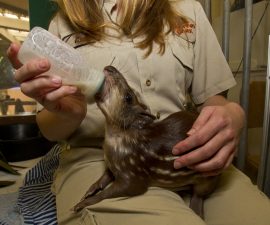We were up before the sun in an effort to beat the heat. July temperatures in Anza Borrego Desert State Park can soar up to around 120 degrees Fahrenheit. We had a little more than an hour’s hike ahead of us from our campsite to our count site in Cougar Canyon. Once we loaded our packs with enough water and supplies to carry us through the day, we were on the trail.
You might be wondering who would be crazy enough to willingly go desert backpacking during the hottest part of the summer. Those were my thoughts, before I became part of this brigade of citizen scientists who volunteer Fourth of July weekend every year to do just that. Our all-girl squad of mammal keepers from the Safari Park (Charlie Hyde, Mandi Makie, and myself) has been “counting sheep” for the past several years at this site. The Safari Park’s mammal department includes another team of counters who have been involved with the program for over 20 years—Gloria Kendall, Eileen Neff, and Michelle Gaffney are seasoned professionals when it comes to spotting sheep!
All of this hard work is an effort to conduct a census on the bighorn sheep population within Anza Borrego Desert State Park. These animal counts are critical in determining how effective recovery efforts are for this species.
With the count in its 45th year, the general trend has been an increase in the number of bighorn within the Peninsular Range. At one time numbers were as low as 400 animals. Although their population has climbed to around 955 animals at best, they are still extremely vulnerable due to habitat loss and fragmentation and disease from livestock.
While bighorn sheep can be seen year-round in the park, we get our most accurate counts from early to mid-summer. Not only does the hot weather drive the sheep down towards their watering holes, where volunteers are stationed nearby to count and identify the animals, but also enough time has elapsed since the lambing season that neonate mortality rates will not skew our numbers. This gives researchers the most realistic snapshot of the current bighorn sheep population in the park.
Once the team has safely reached the observation site, we sit quietly for the next 10 hours scanning the hillsides for any sign of movement. After nearly an hour, Charlie signaled that she’d spotted sheep. We all looked directly across the canyon where two individuals, an ewe and a young ram, had been sitting in the shade watching us the entire time. Clearly unfazed, they continued to rest for several hours before moving down the hillside. We saw this pair, nicknamed “Blondie” and “the Dark Ewe,” several times over the next three days.
In years past, our team has been lucky enough to encounter a desert tortoise each time we’ve camped near Cougar Canyon. As we hiked out on our last day in the park, I worried that we wouldn’t encounter this elusive animal. When the air temperature and the sand heat up, these reptiles hunker down in their burrows to stay cool, not emerging until early evening. We were running out of time.
Once we reached the last stretch of trail before our ascent into another canyon, I glanced to my right and spotted a large moving rock. Staring back at me was a big, beautiful desert tortoise! Unable to believe my eyes, I excitedly called to Mandi and Charlie to check it out. The tortoise had no obvious markings on it to suggest that it was an animal researchers were monitoring. It’s good to know that there is a tiny group of tortoises flourishing on their own in this inhospitable habitat. After we gave this little guy (or gal) a good once over so that we could share details of our encounter with park rangers, we were back on our sheep finding expedition.
Hours passed in the blistering heat on our final count day, and there were no sheep to be found. What a way to end our trip! We packed up and made our way back to camp, checking for tortoise burrows along the way, when a flash of movement caught my eye. Gracefully running across the valley wash was a herd of 11 bighorn sheep! Many of the individuals we had counted and nicknamed were in the group. There was “Dark Chocolate,” a beautiful ram who was over 11 years old; “Old Girl” and her two lady friends; as well as some other young males who were new to us. Altogether, we spotted 18 different bighorn sheep over the four-day weekend—a new best for our team.
With that incredible experience fresh in our minds, we ended our outdoor endurance test and headed back to the ranger station to tally the sheep numbers from all of the teams.
The overall total from all count sites was 253 bighorn sheep. This number fell short of what we’ve seen in the past few years, but it may be due to lack of volunteer sheep counters; not all observation areas were staffed.
Special thanks to the San Diego Zoo Safari Park Mammal Department for the support they offered this keeper team on our latest field excursion.
Amanda Lussier is a keeper at the San Diego Zoo Safari Park. Read her previous blog, Party Time: Leroy the Giraffe Turns One!









